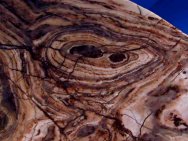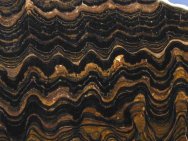Stromatolites are not only Earth's oldest of fossils, but are intriguing in that they are our singular visual portal into deep time on earth, the emergence of life, and the evolving of the beautiful forms of life of modern time. A small piece of stromatolites encodes biological activity perhaps spanning thousands of years. In broad terms, stromatolites are fossil evidence of the prokaryotic life that remains today, as it has always been, the preponderance of biomass in the biosphere. For those that subscribe
 to the theory of the living earth, it is the prokaryotes that maintain the homeostasis of the earth, rendering the biosphere habitable for all other life. They maintain and recycle the atomic ingredients of which proteins, the essence of life, are made, including oxygen, nitrogen and carbon. We humans are, in simple terms, bags of water filled with proteins and prokaryotic bacteria (the bacteria in your body outnumber the cells in your body about 10 to 1). We humans have descended from organisms that adapted to living in a prokaryotic world, and we humans retain (conserved in evolutionary terms) in our mitochondria the cellular machinery to power our cells that we inherited from the prokaryotes of deep time on earth.
to the theory of the living earth, it is the prokaryotes that maintain the homeostasis of the earth, rendering the biosphere habitable for all other life. They maintain and recycle the atomic ingredients of which proteins, the essence of life, are made, including oxygen, nitrogen and carbon. We humans are, in simple terms, bags of water filled with proteins and prokaryotic bacteria (the bacteria in your body outnumber the cells in your body about 10 to 1). We humans have descended from organisms that adapted to living in a prokaryotic world, and we humans retain (conserved in evolutionary terms) in our mitochondria the cellular machinery to power our cells that we inherited from the prokaryotes of deep time on earth.Scientists disagree on how to define stromatolites. A common definition goes something like: A lamiated rock formed by the growth of blue-green algae (i.e., cyanobacteria)". This definition is, in fact, such a gross oversimplification as be scientifically useless. It does contain a modicum of truth, however, in that the largest volume of stromatolite formations was likely formed by biogenic processes involving photosynthetic cyanobacteria. Cyanobacteria’s metabolic byproduct, oxygen, rusted the earth, pumped enormous oxygen poison to them into earth’s atmosphere, and in so doing paved the way for aerobic-based life to emerge and diversify; cyanobacteria’s contributions to life led to their own prodigious decline.
 Stromatolites and their close cousins the thrombolites, are rock-like buildups of microbial mats that form in limestone- or dolostone-forming environments. Together with oncoids (formerly called "algal biscuits" or "Girvanella"), they typically form by the baffling, trapping, and precipitation of particles by communities of microorganisms such as bacteria and algae. In some cases, they can form inorganically, for example when seawaters are oversaturated with certains chemicals resulting in precipitation. Stromatolites are defined as laminated accretionary structures that have synoptic relief (i.e., they stick up above the seafloor). Stromatolite-building communities include the oldest known fossils, dating back some 3.5 billion years when the environments of Earth were too hostile to support life as we know it today. We can presume that the microbial communities consisted of complex consortia of species with diverse metabolic needs, and that competition for resources and differing motility among them created the intricate structures we observe in these ancient fossils. Microbial communities diversified through time, with eukaryotic organisms eventually joining the mix.
Stromatolites and their close cousins the thrombolites, are rock-like buildups of microbial mats that form in limestone- or dolostone-forming environments. Together with oncoids (formerly called "algal biscuits" or "Girvanella"), they typically form by the baffling, trapping, and precipitation of particles by communities of microorganisms such as bacteria and algae. In some cases, they can form inorganically, for example when seawaters are oversaturated with certains chemicals resulting in precipitation. Stromatolites are defined as laminated accretionary structures that have synoptic relief (i.e., they stick up above the seafloor). Stromatolite-building communities include the oldest known fossils, dating back some 3.5 billion years when the environments of Earth were too hostile to support life as we know it today. We can presume that the microbial communities consisted of complex consortia of species with diverse metabolic needs, and that competition for resources and differing motility among them created the intricate structures we observe in these ancient fossils. Microbial communities diversified through time, with eukaryotic organisms eventually joining the mix.
Excluding some exceedingly rare Precambrian fossils such as the Ediacaran fauna, stromatolites and are the only fossils encoding the first 7/8th of the history of life on earth. They encode the role that ancient microorganisms played in the evolution of life on earth and in shaping earth's environments. The fossil record of stromatolites is astonishingly extensive, spanning some four billion years of geological history with the forming organisms possibly having occupied every conceivable environment that ever existed on earth. Today, stromatolites are nearly extinct in marine environments, living a precarious existence in only a few localities worldwide. Modern stromatolites were first discovered in Shark Bay, Australia in 1956, and throughout western Australia in both marine and non-marine environments. New stromatolite localities have continued to be discovered in various places such as the Bahamas, the Indian Ocean and Yellowstone National Park, to name but a few localities.







